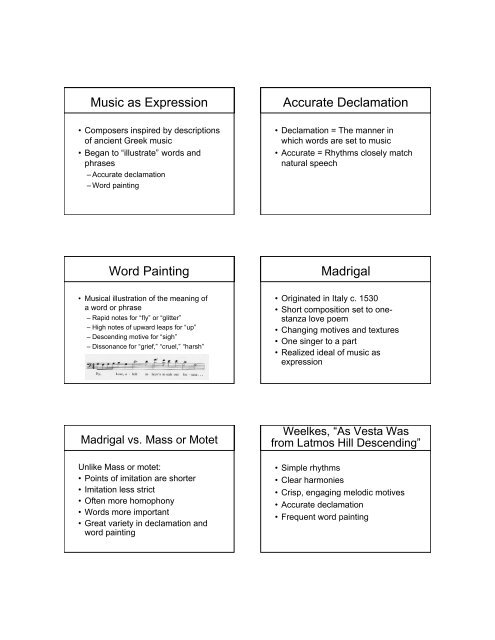Chapter 7 Renaissance Timeline The Renaissance ... - John Chittum
Chapter 7 Renaissance Timeline The Renaissance ... - John Chittum
Chapter 7 Renaissance Timeline The Renaissance ... - John Chittum
You also want an ePaper? Increase the reach of your titles
YUMPU automatically turns print PDFs into web optimized ePapers that Google loves.
Music as Expression<br />
• Composers inspired by descriptions<br />
of ancient Greek music<br />
• Began to “illustrate” words and<br />
phrases<br />
– Accurate declamation<br />
– Word painting<br />
Word Painting<br />
• Musical illustration of the meaning of<br />
a word or phrase<br />
– Rapid notes for “fly” or “glitter”<br />
– High notes of upward leaps for “up”<br />
– Descending motive for “sigh”<br />
– Dissonance for “grief,” “cruel,” “harsh”<br />
Madrigal vs. Mass or Motet<br />
Unlike Mass or motet:<br />
• Points of imitation are shorter<br />
• Imitation less strict<br />
• Often more homophony<br />
• Words more important<br />
• Great variety in declamation and<br />
word painting<br />
Accurate Declamation<br />
• Declamation = <strong>The</strong> manner in<br />
which words are set to music<br />
• Accurate = Rhythms closely match<br />
natural speech<br />
Madrigal<br />
• Originated in Italy c. 1530<br />
• Short composition set to onestanza<br />
love poem<br />
• Changing motives and textures<br />
• One singer to a part<br />
• Realized ideal of music as<br />
expression<br />
Weelkes, “As Vesta Was<br />
from Latmos Hill Descending”<br />
• Simple rhythms<br />
• Clear harmonies<br />
• Crisp, engaging melodic motives<br />
• Accurate declamation<br />
• Frequent word painting


